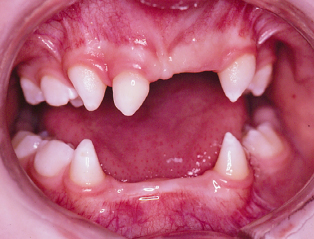41
Missing Teeth and Extra Teeth
Hypodontia
There are many alternative terminologies for missing teeth, including hypodontia, oligodontia (only a few teeth) and anodontia (complete absence of teeth); and the absence of teeth is the most common dental anomaly with up to 9% of people affected. While the number of missing teeth is important, of more relevance is what type of tooth is absent. Table 41.1 shows the anomalies that exist at different stages of tooth development.
Table 41.1 Stages of tooth development.

Commonly, the lateral incisors, second premolars or third molars are absent. It is rare to have absence of the first molars, canines or central incisors and further investigation is required to exclude possible syndromes or other congenital abnormalities.
Ectodermal Dysplasias (ED) (Fig. 41.1)
This represents a group of conditions where any or all of the ectodermally derived tissues may be affected, including skin, nails, hair and teeth. The classical sex-linked hypohidrotic form affects boys most severely, with many missing teeth, fine sparse hair and the absence of sweat glands. Female carriers are less severely affected and are often diagnosed due to their hypodontia.
Figure 41.1 The typical appearance of a child with ectodermal dysplasia with multiple missing teeth and conical form of other teeth.

Management Problems with Hypodontia
- Aesthetics.
- Association with other dental anomalies (conical teeth).
- Diminished vertical dimension or lack of bilateral support.
- Speech and articulation disorders.
- Lack of adequate anchorage for conventional orthodontics.
- Impacted teeth due to lack of guidance for erupting teeth.
Treatment Planning
Ultimately, every child is different and there must be an individualised plan for each patient, based on their social, functional and aesthetic needs. While some adolescents may be too young for complex treatment, the absence of teeth in this social age group is importan/>
Stay updated, free dental videos. Join our Telegram channel

VIDEdental - Online dental courses


